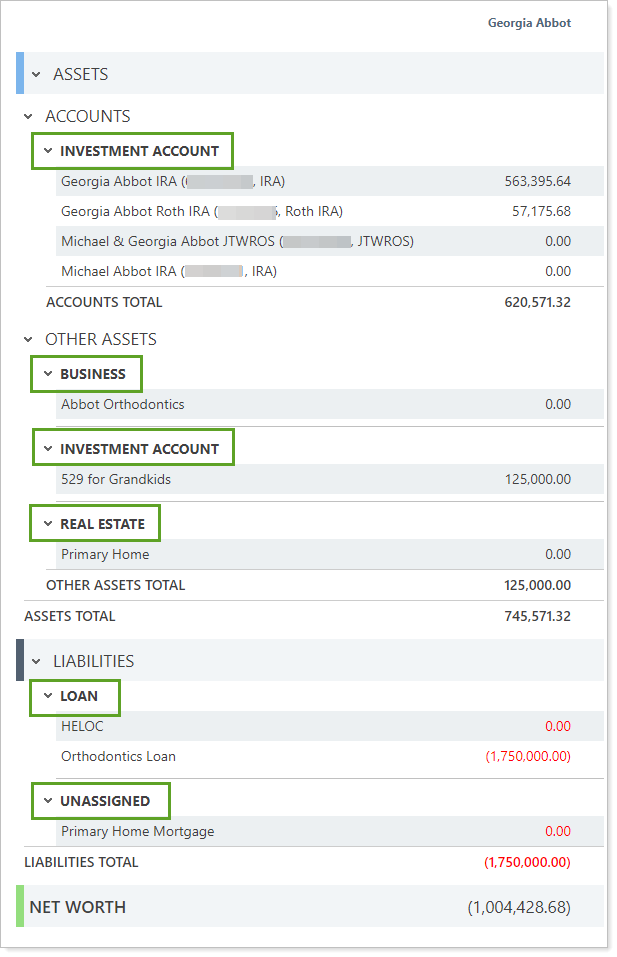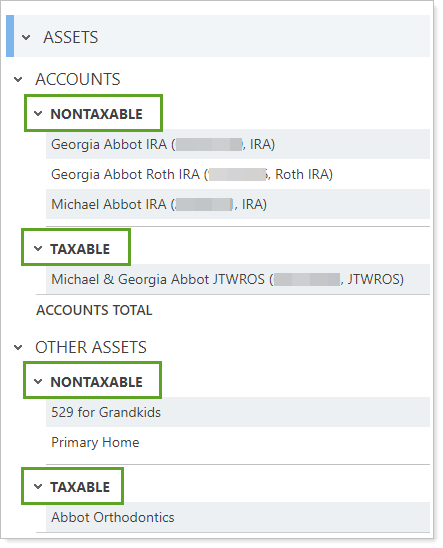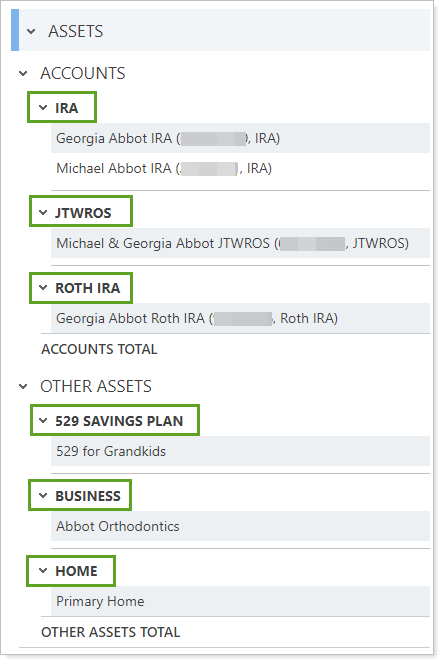Contents
How Group By/Then By Works
| Applies to: | ||
|---|---|---|
| ✔ Dynamic |
✔ Client Portal |
|
This setting allows you to organize a report by various categories, with up to three levels of grouping. You can also choose to leave Group by blank, and the report will organize listings based on default sorting. Grouping allows you to organize the data in your report various different ways depending on the story you want to tell.
For each grouping, you can choose to show or hide subtotals.
In Dynamic Reports

The categories available are determined by your firm. For more information on setting up categories, see Categories.
Example 1
If you want to see the holdings by asset class in all the accounts in a specific Household, you could create a Holdings report with the following grouping settings:

With this grouping, the report groups by account first, then by the asset classes held within each account. You can expand or collapse each account and asset class to view details.
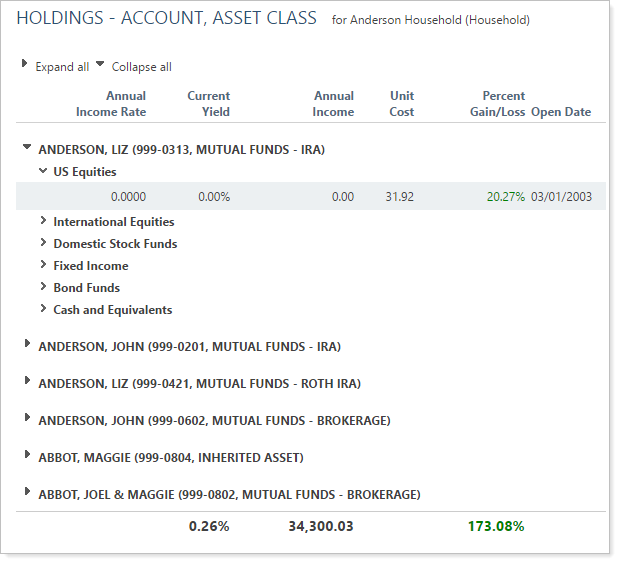
Example 2
If, on the other hand, you were more interested in the asset classes, you might use the following grouping:

With this grouping, the report groups by asset class first, then by the account that holds each asset class.
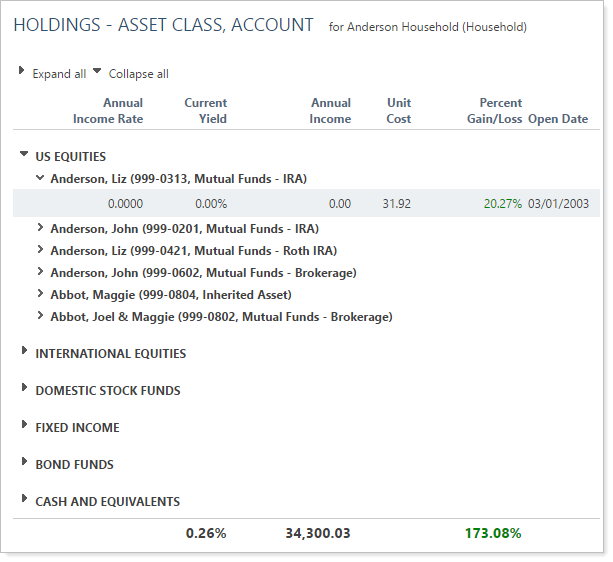
Example 3
If you want to see an Asset Allocation report showing what accounts in an a group hold which security types, you can apply the following Group by settings:

With this grouping, the report groups by account first, then by the security types held within each account. You can click on the chart or in the table to see more details and highlight the data.
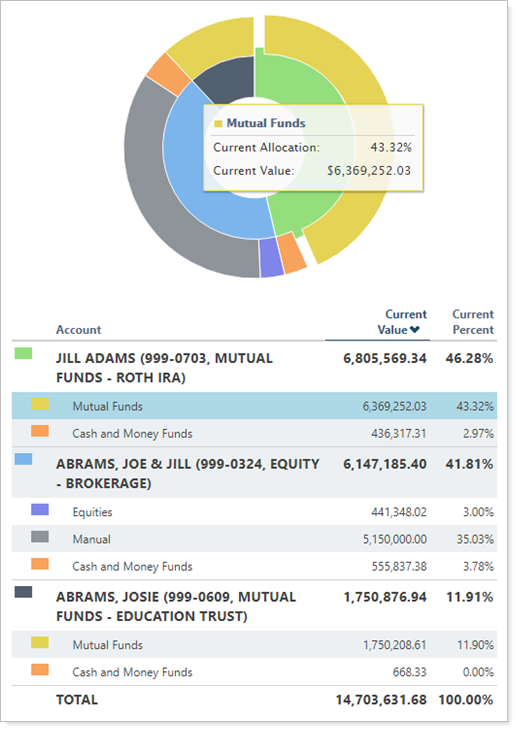
When you select the Group by check box, you can apply the following setting to the dynamic report.
Show Subtotals
On some report types, you can select the Show subtotals check box next to each Group by/then bycategory if you want to see a subtotal for each of those categories.
Best Practice
Choose Show subtotals for at least the first grouping.
You might choose to select just a high-level subtotal for the first Group by category so you can see some detail with the rows collapsed, but then omit any subtotals for smaller categories to keep the table manageable.
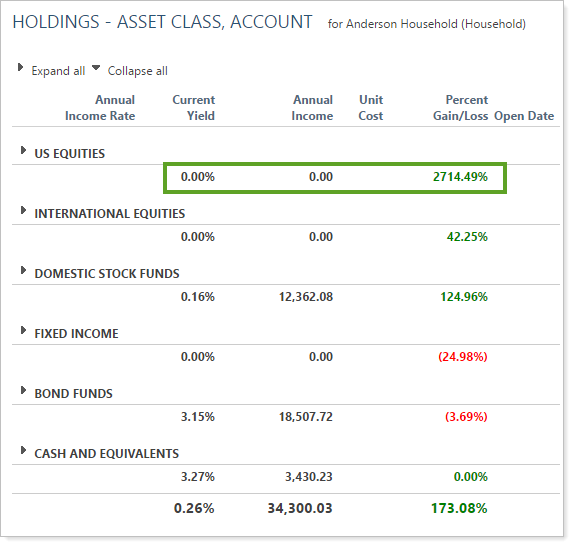
Transactions Report
In the Transactions report, the Group By option allows you to use the report either as an accounting of transactions or as a cash ledger.

-
Activity Type: Select to produce a report based on the specific type of activity you want to evaluate. For example, select Activity Type if you want to look at all the withdrawals and deposits in an account.
-
Money Security: Select to produce a cash ledger report that tabulates all the cash and money security activity within an account or group over the specific date period. This report starts with Beginning Cash Balance, adds or subtracts all cash transactions as applicable, and totals everything to the Ending Cash Balance.
Note
Since the Cash Balance columns sum when viewing this report, dynamic sorting is disabled. Columns automatically sort by date, and then by activity type alphabetically.
For more information about this feature, see See Cash-Impacting Transactions and Group By Activity Type or Money Security.
Net Worth Report
In the Net Worth report, the Group By/Then By option allows you to choose how assets and liabilities are grouped in the table.

You can choose to group by the following:
-
Net Worth Category
-
Tax Status
-
Type (called Account Type in accounts and Asset/Liability Type in assets and liabilities)
These fields are controlled in different places depending on whether you're reporting on accounts or assets and liabilities. The following table shows you where to go to edit each field.
| Category to Group By | Where to Edit This Field: Investment Accounts | Where to Edit This Field: Assets and Liabilities |
|---|---|---|
|
Net Worth Category |
Setting: Net Worth Category list Location: The Report Settings Panel |
Setting: Net Worth Category list Location: Assets and Liabilities |
| Tax Status |
Setting: Taxable check box Location: The Account Settings Panel |
Setting: Taxable check box Location: Assets and Liabilities |
| Type |
Setting: Account Type list Location: The Account Settings Panel |
Setting: Asset/Liability Type list Location: Assets and Liabilities |
The following table shows each Group By option.
| Setting | Report Output |
|---|---|
| Group by set to Net Worth Category |
All accounts, assets, and liabilities are sorted based on the Net Worth Category classification. Anything not assigned a classification is displayed under Unassigned. |
| Group By set to Tax Status |
All accounts, assets, and liabilities are sorted based on the Tax Status classification.
|
| Group By set to Type |
|
Income and Expenses Report
On the Income and Expenses report, this setting allows you to group by any of your firm's security categories.

-
To only use the Sort by configuration, leave Group by set to <None>.
-
To first group by security category, then by Sort by configuration, choose the desired category from the list.
| Setting | Report Output |
|---|---|
| Group By set to None |
All the accounts are displayed according to the Sort by configuration. |
| Group By set to Asset Class |
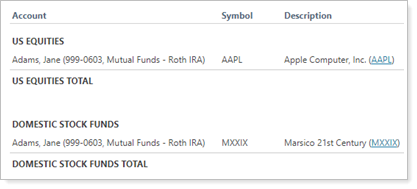
The accounts are first grouped by asset class, then within the grouping, they are displayed according to the Sort by configuration. |
In PDF Reports
This setting works the same in most PDF reports as in dynamic reports.
When you select the Group by check box, you can apply the following setting to the PDF report.
Show Subtotals
As with dynamic reports, you can choose to show subtotals for each grouping level on PDF reports. On PDF reports, however, you can choose whether to show those subtotals beneath each grouping (the same way it displays on dynamic reports) or in several other locations on the page.

Your options for where to display subtotals are:
-
None. No subtotals will be shown on the report.
-
At the top. Subtotals are displayed at the beginning of each subsection with a Category 1 Total PDF template style applied.
-
At the bottom. Subtotals are displayed at the end of each subsection with a Category 1 Total PDF template style applied.
-
Inline. Subtotals displayed at the beginning of each section as part of the subsection header.
| Setting | Report Output |
|---|---|
| Show subtotals set to at the top |
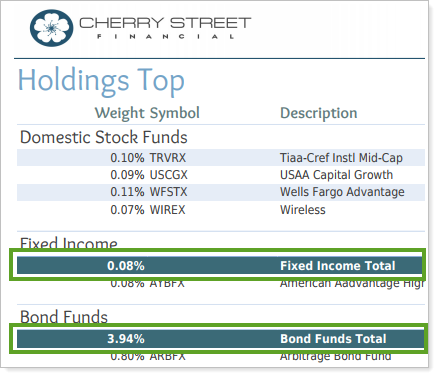
In this example, you see subtotals listed at the beginning of each section. Notice that the Domestic Stock Funds section, which started on the previous page and finished on this page, does not include a subtotal at the bottom. The subtotal for that section appears on the previous page at the beginning of the Domestic Stock Funds section. |
| Show subtotals set to at the bottom |
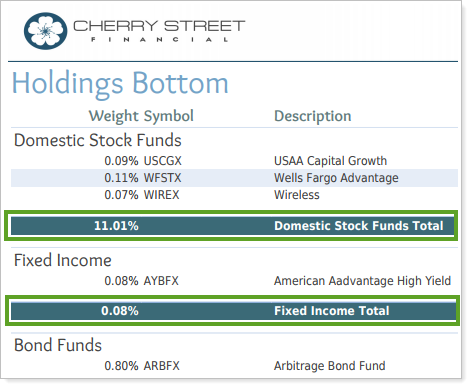
In this example, you see subtotals listed at the beginning of each section. Notice that the Domestic Stock Funds section, which started on the previous page and finished on this page, includes a subtotal at the bottom. No subtotal is shown on the previous page for Domestic Stock Funds, however. |
| Show subtotals set to inline |
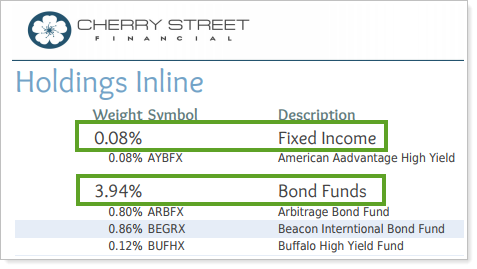
In this example, you see subtotals listed at the beginning of each section as part of the subsection header. The header is reorganized to list each subtotal data type in the appropriate column. This option takes up less space on the page than at the top or at the bottom because it doesn't add another line to each subsection. |
Reports With This Setting
Performance Reports
Holdings Reports
Transaction Reports
Financial Planning Reports
|
|
Related Settings
The following setting interacts with this option:



